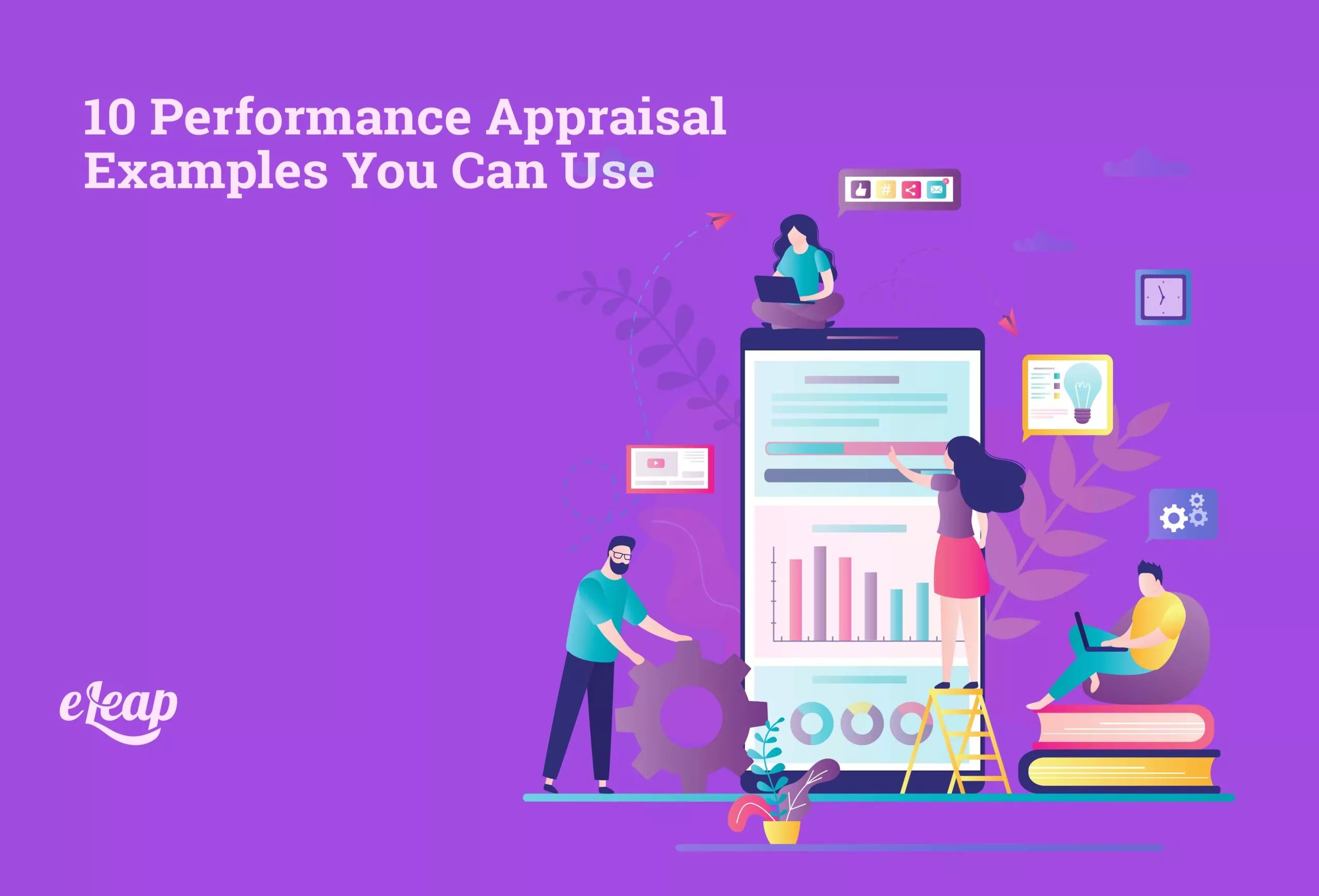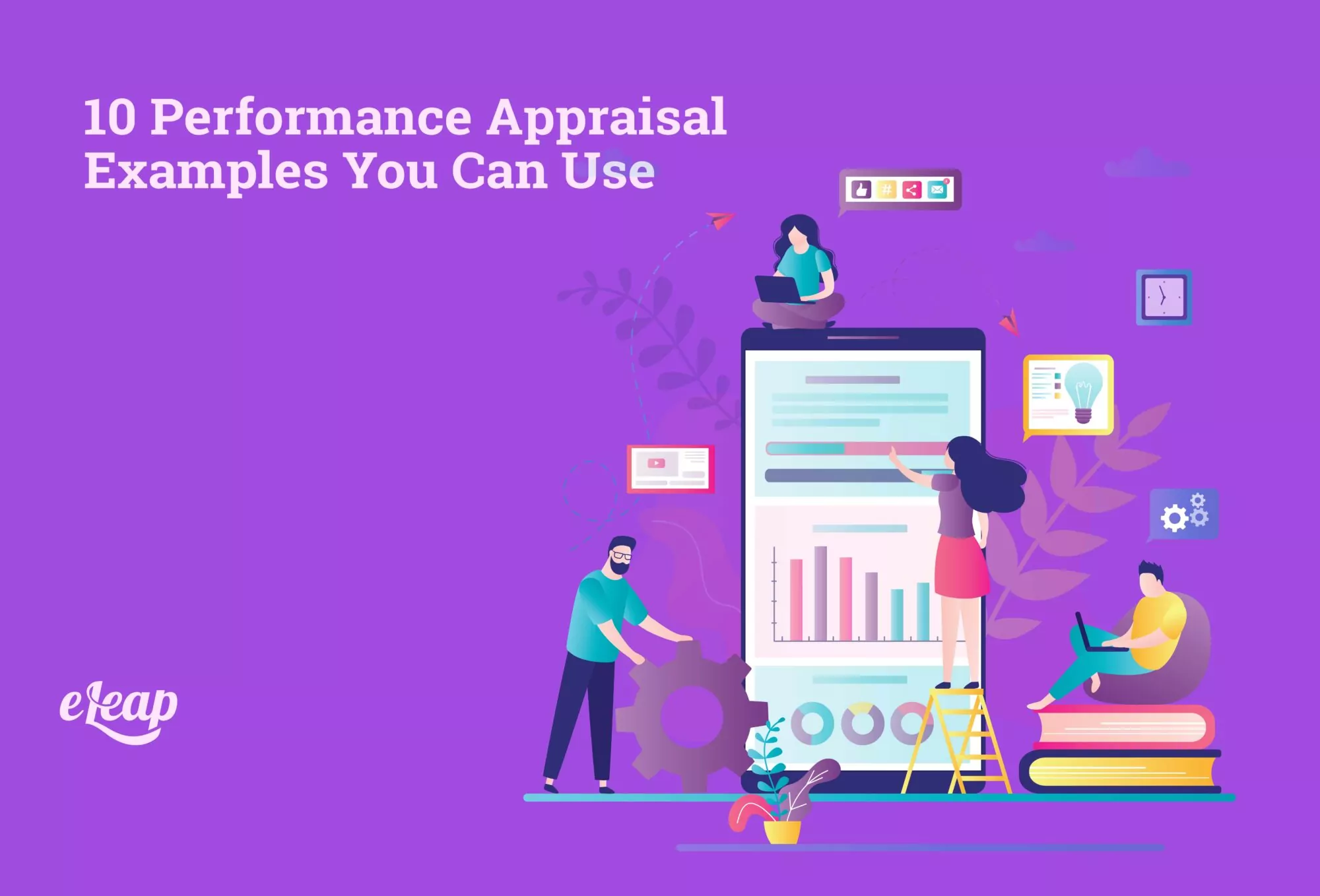10 Performance Appraisal Examples You Can Use

Performance appraisal examples play a crucial role in the success of any organization. When done correctly, they help ensure that employees receive constructive feedback, helping them grow and meet their career goals. As a manager or HR professional, it’s essential to have adequate performance appraisal examples at your disposal to make your reviews more structured and impactful. This article will cover 10 actionable performance appraisal examples you can implement immediately to help assess various employee skills and performance areas. Explore how eLeaP®’s Performance Management Platform can simplify evaluations, boost productivity, and drive measurable results.
By the end of this article, you’ll understand how to approach employee appraisals with clarity and purpose. These examples can be used across various industries and help you create a more effective evaluation process for your team.
What are Performance Appraisal Examples?
Performance appraisals Examples are systematic evaluations of an employee’s job performance, skills, and potential. They allow employees and managers to discuss the individual’s work contributions, achievements, areas for improvement, and professional development goals. Performance appraisals are vital for tracking progress, boosting morale, and aligning team efforts with company objectives.
When executed well, performance appraisals serve as a cornerstone for professional growth. Regular feedback allows employees to understand where they stand within an organization, fostering a culture of continuous improvement. Whether conducted annually, semi-annually, or quarterly, these reviews guide employees toward better performance while allowing managers to align expectations and recognize accomplishments.
Why Performance Appraisals Matter

Performance appraisals Examples are not just a formality. They provide numerous benefits, both to the employees and the organization as a whole. When done correctly, they:
- Clarify expectations: This will help employees better understand what’s expected of them, reducing confusion and increasing motivation.
- Facilitate goal setting: Appraisals help employees set SMART (Specific, Measurable, Achievable, Relevant, and Time-bound) goals that can guide their performance for the coming period.
- Drive professional development: Performance reviews highlight skills gaps and areas for improvement, encouraging employees to pursue learning and development opportunities.
- Support recognition and rewards: A well-conducted performance appraisal highlights employees’ achievements, often leading to bonuses, promotions, or recognition.
- Enhance communication: These reviews create a dialogue between managers and employees, allowing open communication that can build stronger working relationships.
Performance appraisals allow managers and employees to take a step back and reflect on progress, challenges, and future goals. When used as a constructive tool, these reviews contribute significantly to the growth and success of individuals and organizations.
10 Performance Appraisal Examples You Can Use
Below, we will explore 10 performance appraisal examples tailored to assess critical employee skills. These examples will help you provide detailed and practical feedback to your team members, ensuring that performance reviews are both fair and constructive.
- Communication Skills
Strong Communication:
“Effectively communicates ideas to team members and management, ensuring everyone is aligned and informed. Uses clear language in meetings and emails, and actively listens to others.”
Needs Improvement:
“Occasionally struggles to articulate thoughts clearly, leading to confusion among team members. Needs to be more mindful of communication channels and ensure concise and well-structured messages.”
Tips for Improvement:
To improve communication skills, encourage employees to practice active listening and regularly check for understanding. Offering communication training or workshops can also help refine their abilities.
- Leadership and Teamwork
Strong Leadership:
“Leads by example, motivating the team to achieve project goals. Takes responsibility for the team’s performance and helps others develop their skills.”
Needs Improvement:
Needs to improve leadership abilities by taking more initiative in guiding the team. Should work on motivating team members and providing clear direction during projects.”
Actionable Feedback:
Encourage mentorship or team-building exercises to strengthen leadership skills. Leadership training could refine employees’ ability to manage teams effectively.
-
Time Management and Productivity
Excellent Time Management:
“Consistently meets deadlines and manages multiple projects simultaneously without compromising quality. Prioritizes tasks efficiently and maintains a high level of productivity.”
Needs Improvement:
“Struggles to prioritize tasks, resulting in missed deadlines. Needs to improve time management skills to enhance productivity and better meet project timelines.”
Tips for Improvement:
Encourage using time-management tools, such as to-do lists, task managers, or time-blocking techniques, to improve focus and organization.
-
Problem Solving and Decision Making
Strong Problem Solving:
“Effectively identifies challenges and provides actionable solutions. Approaches problems logically and considers all possible options before making decisions.”
Needs Improvement:
“Requires support in solving complex problems and often takes longer to make decisions. Needs to develop more confidence in decision-making abilities.”
Actionable Feedback:
Encourage employees to tackle minor challenges independently before handling more complex issues. Additionally, providing opportunities for learning decision-making strategies can be beneficial.
-
Adaptability and Flexibility
Highly Adaptable:
“Adapts well to changing work conditions and responsibilities. Quickly adjusts to new tasks or processes and remains focused on delivering results despite changes.”
Needs Improvement:
“Resistant to changes in work processes and may struggle with new tasks. Needs to be more open to adjusting to evolving work environments.”
Actionable Feedback:
Encourage employees to embrace a growth mindset. Offer exposure to new roles or tasks to help them become more adaptable. Cross-training can also enhance flexibility.
-
Work Ethic and Professionalism
Strong Work Ethic:
“Consistently displays a high level of dedication to their work, going above and beyond to ensure that all tasks are completed on time and to the highest standard.”
Needs Improvement:
“Occasionally lacks initiative and needs to be reminded to complete tasks. Could benefit from setting higher personal standards for work output.”
Tips for Improvement:
Set clear, achievable goals and provide regular check-ins to ensure the employee stays on track. Recognizing achievements and rewarding positive behavior can also help encourage a strong work ethic.
-
Creativity and Innovation
Highly Creative:
“Regularly brings innovative ideas that improve team processes or product offerings. Thinks outside the box and contributes significantly to brainstorming sessions.”
Needs Improvement:
“Relies on standard approaches and rarely contributes new ideas. Needs to focus on finding creative solutions to problems rather than following routine procedures.”
Actionable Feedback:
Encourage employees to participate in brainstorming sessions and explore unconventional solutions. Fostering an open environment for creativity can inspire new ideas.
-
Conflict Resolution and Emotional Intelligence
Excellent Conflict Resolution:
Handles workplace conflicts with professionalism and tact. Works to mediate and find solutions that satisfy all parties involved, maintaining positive relationships.”
Needs Improvement:
“Tends to avoid conflicts, which can sometimes lead to unresolved issues. Needs to develop better conflict-resolution skills and learn to address problems promptly.”
Tips for Improvement:
To help employees improve, consider offering conflict management training or workshops focusing on emotional intelligence and negotiation skills.
-
Initiative and Proactivity
Takes Initiative:
“Proactively identifies tasks and areas for improvement without being asked. Seeks opportunities to contribute and often leads projects or takes charge when needed.”
Needs Improvement:
“Waits for instructions and often requires supervision. Needs to develop a more proactive approach to taking on tasks and identifying areas for growth.”
Actionable Feedback:
Encourage employees to take ownership of their projects and suggest areas for improvement. Giving them more responsibilities can help foster a proactive mindset.
-
Customer Service and Client Relations
Strong Client Relations:
“Develops strong, long-lasting relationships with clients. Anticipates client needs and provides excellent customer service, ensuring high client satisfaction.”
Needs Improvement:
“Struggles to build rapport with clients and sometimes falls short in addressing client concerns. Needs to focus on improving communication and responsiveness.”
Tips for Improvement:
Encourage employees to engage more with clients, asking for feedback and offering personalized solutions. Providing customer service training could also help improve these skills.
Best Practices for Writing Effective Performance Appraisals
Writing an effective performance appraisal is just as important as the content of the review itself. When writing appraisals, it’s essential to use clear, actionable language that avoids ambiguity. Here are some best practices to ensure your performance appraisals are effective:
Use Clear, Specific Language
Avoid vague or generic comments. Provide concrete examples of how an employee’s actions have positively impacted their performance. For example, instead of saying, “Good communicator,” use phrases like, “Effectively conveyed project timelines to the team, ensuring all deadlines were met.”
Provide a Balanced Review
An effective performance appraisal includes both strengths and areas for improvement. Offering positive feedback along with constructive criticism helps employees understand their performance from a holistic perspective. This balance motivates employees to improve while reinforcing what they are doing well.
Incorporate Constructive Feedback
Constructive feedback should be actionable. Instead of simply pointing out weaknesses, offer clear guidance on how the employee can improve. For instance, instead of stating, “Needs to improve time management,” suggest, “Consider using time-blocking techniques to manage deadlines more effectively.”
Focus on Long-Term Growth
Performance appraisals should not just focus on the past but also look ahead. Set goals for the employee’s future growth and outline the steps they can take to reach these objectives. This forward-thinking approach helps employees feel motivated and supported in their development.
How to Conduct a Successful Performance Appraisal
Conducting a successful performance appraisal involves more than just reviewing the employee’s performance. It requires preparation, effective communication, and a focus on future growth.
Preparation Before the Appraisal Meeting
Before the performance appraisal meeting, gather all relevant data, including feedback from peers, results of previous evaluations, and employee self-assessments. This comprehensive view allows you to provide accurate and meaningful feedback.
During the Appraisal: How to Make It Effective
During the appraisal, be transparent, honest, and respectful. Use the meeting as an opportunity for two-way communication, allowing employees to share their thoughts and feedback. Discuss accomplishments and growth areas and set clear expectations for the future.
Post-Appraisal: Tracking Progress and Setting New Goals
After the appraisal, monitor the employee’s progress toward the goals discussed. Regular check-ins and feedback sessions will help ensure the employee stays on track and receives the support needed for continued growth.
Conclusion:
Performance appraisals are essential tools for improving employee performance and fostering career development. You can ensure that your appraisals are impactful by using clear examples, maintaining a balanced approach, and offering actionable feedback. Remember, performance appraisals should always focus on growth, providing employees with the insights they need to reach their full potential.
At eLeaP, we understand the importance of performance management and offer tools to help organizations streamline their appraisal processes. By embracing these performance appraisal examples, you can create a culture of continuous improvement and set the foundation for long-term success.